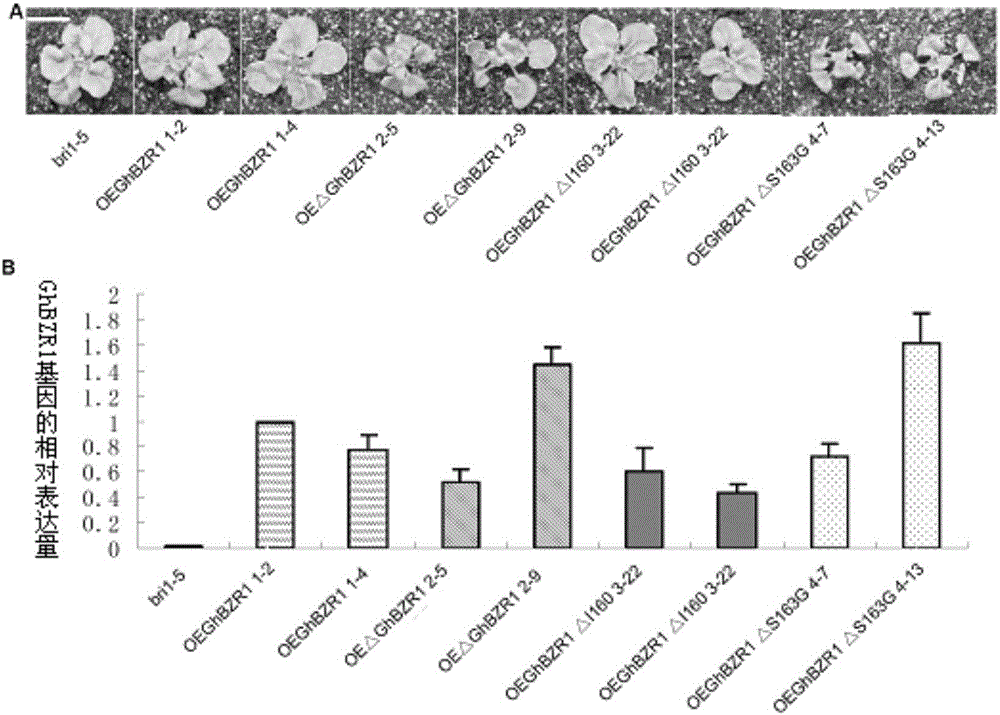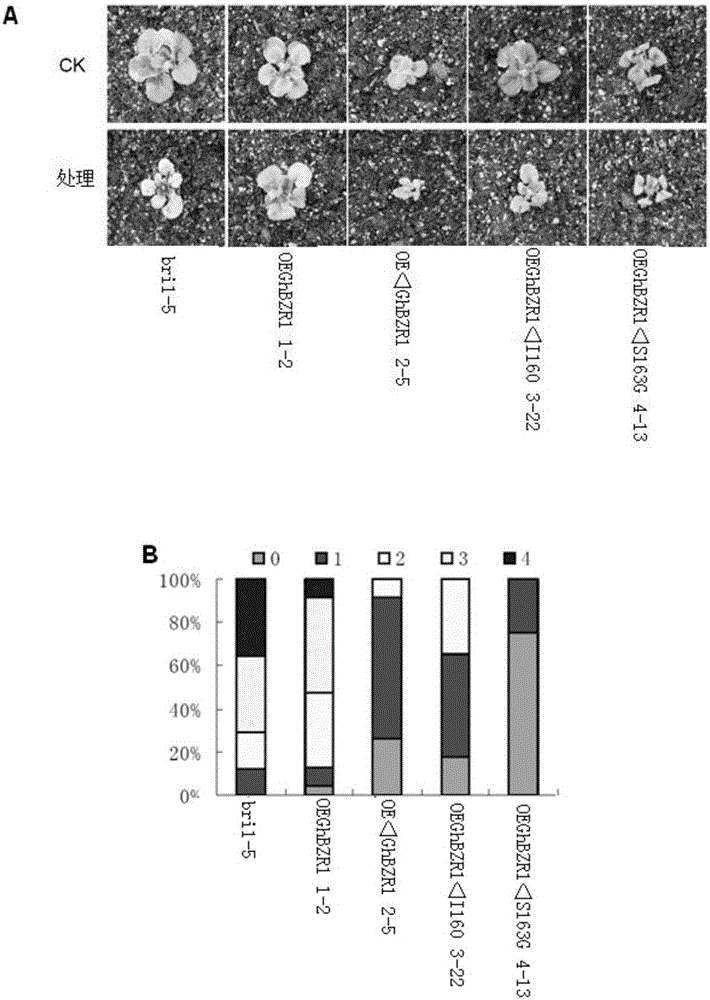Application of protein and encoding gene of protein in regulation of verticillium wilt resistance of plants
A technology for transgenic plants and proteins is applied in the application field of proteins and their encoded genes in regulating the resistance of plants to Verticillium wilt, and can solve the problems of lack of effective resistance sources and difficulty in achieving ideal effects.
- Summary
- Abstract
- Description
- Claims
- Application Information
AI Technical Summary
Problems solved by technology
Method used
Image
Examples
Embodiment 1
[0100] Embodiment 1, the cloning of the coding gene of protein GhBZR1 and the coding gene of GhBZR1 mutein
[0101] 1. Cloning of the gene encoding the protein GhBZR1
[0102] The inventors of the present invention cloned the gene encoding the protein GhBZR1, namely the GhBZR1 gene, from upland cotton TM-1.
[0103] 1. The total RNA of the leaves of upland cotton TM-1 seedlings grown to 14 days was extracted by the Trizo1 method, and then the first-strand cDNA was reverse-transcribed by reverse transcriptase AMV.
[0104] 2. Artificially synthesized primers F: 5'-CACCATGACGTCAGATGGGGCGACGT-3' and R: 5'-ACATCGAGCTTTCCCACTTCCG-3'.
[0105] 3. After completing steps 1 and 2, use the cDNA extracted in step 1 as a template and use F and R as primers for PCR amplification to obtain a double-stranded DNA molecule of about 940 bp.
[0106] 4. Ligate the double-stranded DNA molecule with the vector pENTR / SD / D-TOPO to obtain the recombinant plasmid pGW-GhBZR1.
[0107] According to t...
Embodiment 2
[0128] Embodiment 2, the acquisition and identification of transgenic Arabidopsis
[0129] 1. Construction of recombinant vector and recombinant Agrobacterium
[0130] 1. Acquisition of recombinant plasmids 35S::GhBZR1-GFP and GV3101 / 35S::GhBZR1-GFP
[0131] The recombinant plasmid pGW-GhBZR1 constructed in Step 1 of Example 1 and the vector pMDC83 were subjected to LR recombination reaction to obtain an LR reaction product.
[0132] The LR reaction product was added to TOP10 competent cells for transformation, and the clone obtained was the target clone, and the plasmid in the target clone was the target plasmid, and the target plasmid was named recombinant plasmid 35S::GhBZR1-GFP. Sequencing results showed that the recombinant plasmid 35S::GhBZR1-GFP contained the DNA molecule shown in the 1st to 939th positions from the 5' end of the sequence 1 in the sequence listing, and expressed the protein GhBZR1 shown in the sequence 2 in the sequence listing.
[0133] The recombina...
Embodiment 3
[0187] Embodiment 3, acquisition and identification of cotton silent strain
[0188] 1. Construction of recombinant plasmid PTRV2-GhBZR1 and acquisition of recombinant Agrobacterium
[0189] 1. The total RNA of the leaves of upland cotton TM-1 seedlings grown to 14 days was extracted by the Trizo1 method, and then the first-strand cDNA was reverse-transcribed by reverse transcriptase AMV.
[0190] 2. Artificially synthesized primers F1: 5'-CGACGACAAGACCCTCACCACTTATCGAAAGGG-3' and R1: 5'-GAGGAGAAGAGCCCTATTTCTGGAGGTTGGAG-3'.
[0191] 3. After completing steps 1 and 2, use the cDNA extracted in step 1 as a template, and use F1 and R1 as primers to carry out PCR amplification, and then purify and recover to obtain a double-stranded DNA molecule of about 300 bp.
[0192] 4. Place the double-stranded DNA molecule obtained in step 3 in T4 DNA synthetase buffer containing dATP, treat at 22°C for 30 minutes, and then place it at 70°C for 20 minutes to obtain Fragment A.
[0193] 5. T...
PUM
 Login to View More
Login to View More Abstract
Description
Claims
Application Information
 Login to View More
Login to View More - R&D
- Intellectual Property
- Life Sciences
- Materials
- Tech Scout
- Unparalleled Data Quality
- Higher Quality Content
- 60% Fewer Hallucinations
Browse by: Latest US Patents, China's latest patents, Technical Efficacy Thesaurus, Application Domain, Technology Topic, Popular Technical Reports.
© 2025 PatSnap. All rights reserved.Legal|Privacy policy|Modern Slavery Act Transparency Statement|Sitemap|About US| Contact US: help@patsnap.com



